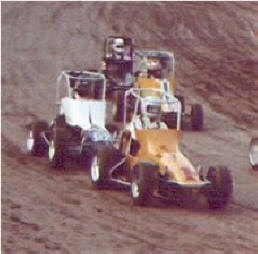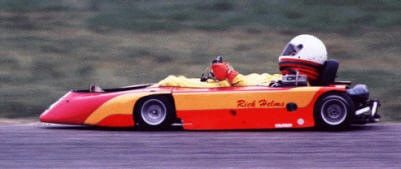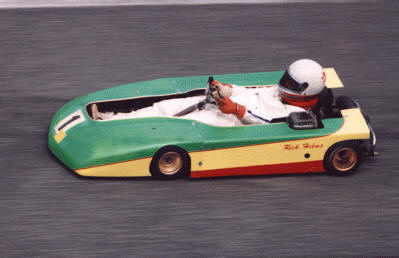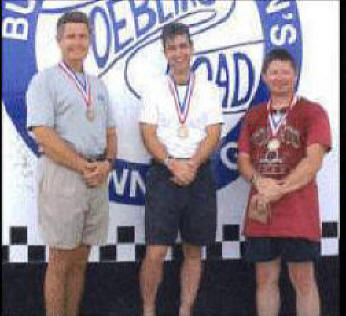
RICK HELMS RACING 1980-1999
Note from Rick:
I started driving racing cars in 1971, when I was sixteen years old, at Little River Raceway in South Carolina. Little River was a 3/8 mile high-banked dirt track that ran hobby cars, modifieds, and Late Model Sportsman stock cars on Friday nights.
I retired from racing in June 1999, after running a Formula Ford open wheel car at Lowes Motor Speedway. In the interim, I drove hobby stock cars, semi-modified six cylinder cars, sprint and enduro karts, modified midgets, three-quarter midgets, late model stock cars, and formula cars, in organizations such as the National Modified Midget Racing Association, the Southeastern Three Quarter Midget Racing Association, the World Karting Association, NASCAR, and the Sports Car Club of America.
I started over 300 races, won twelve of them, won the WKA Carolinas Cup Championship at Rockingham, and finished in third place in the South Atlantic Road Race of Champions at Roebling Road in Savannah.
On this page, I've tried to chronicle some of the racing cars I drove over the years.

This is the only questionable picture I have. This one may be me, and then again it may not. I'm not really certain. The track looks like Cedar Square near Greensboro, where I ran TQ midgets around 1980; the car looks like the one I drove, and the helmet looks like mine. If this is me, I'm in car #1. I found this picture on the internet, and if it isn't me, then it looks almost exactly the way I'd have looked in the TQ I drove in the STQMRA.
Three Quarter Midgets are about the same size as regular USAC midgets, but they run motorcycle engines instead of the four-cylinder engines that USAC midgets use.

This is the enduro kart I drove to the WKA Carolinas Cup Championship at Rockingham in 1991. Enduro karts are capable of speeds up to 110 miles per hour. I'd bought this one from John Kluttz at Competition Karting Technologies in 1989, and drove it in World Karting Association National and Regional Championship races at Daytona, Charlotte, Summit Point, Rockingham, and Roebling Road in Savannah. At the beginning of the 1991 season, I started having my engines built by Jim Perry at Chicago Karting Technologies (note the CKT on the side of the engine). I won all but one race at Rockingham that season, and finished second in the one I didn't win, to take the championship.

This picture is from my last season racing enduro karts, in 1992. Shortly after winning the Carolinas Cup Championship in 1991, I learned that I had cancer. Following surgery and intensive radiation therapy, I returned to racing around the middle of the 1992 season. I had also put a new body on the kart from the previous season. I'm shown here driving in a WKA National Championship race at Charlotte Motor Speedway. I finished third in points that year, which--all things considered--wasn't such a bad deal.
Ladies and gentlemen, meet the Car From Hell. This was a Howe Fifth Design car I bought in 1993 to run in NASCAR Late Model Sportsman events. I'm shown here doing about 125 miles per hour down the front stretch at Concord Motor Speedway. This particular car was just bad luck for everyone who touched it. The first guy who owned it went to prison for selling cocaine. The second contracted diabetes. All it did to me was suck my wallet dry. It was originally a Camaro, but by the time this picture was taken it had been rebodied as a Chevrolet Lumina (this picture is from around 1996).
I decided at the end of the 1996 season to dump it and go racing in the Sports Car Club of America. This pig had to get one last dig in. On the morning I was taking it to a race car auction in Charlotte, the tie-downs broke and it rolled off the trailer in the middle of rush hour traffic. I didn't have any more tie-downs, so I had to hire a rollback to take it the rest of the way to the auction.
Good riddance. To the guy who bought it that day, I'd like to offer my sincerest apologies.
In 1997, I went from the world's all-time worst racing car to the world's sweetest. This was a Reynard RF83 Formula Ford I picked up after dumping the stock car. This was one amazing ride. Formula Fords are open-wheel, open-cockpit, single-seat sports cars running 1.6 liter four-cylinder Ford engines, but they only weigh about 900 pounds, so they can easily reach a top end between 140 and 150 miles per hour.
The top picture was the first one taken with me and the car. The bottom one was taken midway through the 1998 SCCA South Atlantic Road Race of Champions season, at Roebling Road, a 2.2 mile road course near Savannah, Georgia.

I won the first three races I ran in the Reynard, and it never finished lower than fourth place. That's how sweet a car it was. By the end of the 1998 SCCA/SARRC season, I had acquired my National SCCA license, and had finished sixth in SARRC points, which entitled me to an invitation to the season-ending SARRC Invitational Challenge, a championship race at Roebling Road. In the picture top left, I'm running in turn five in the SIC. What you can't see, thanks to the smoked shield on my helmet, is the very worried look on my face, because my oil pressure gauge kept dropping to 5 PSI in the middle of each right hand corner -- which is most of the corners at Savannah (normal oil pressure is about 80 PSI). I kept waiting for the engine to blow, but it was a stout little mill, Not only did it make it through the entire race, but I finished third, a podium finish!
In the right hand picture above, I'm in Victory Lane with the winner of the race, Bob Poma (center), and John Swanson, who finished in second place. Actually, Bob and I are the same height, but the winner gets to stand on a higher platform. Third place stands on the ground.
Following the 1998 season, I rebuilt the engine and repainted the car in Charlotte Hornets colors -- hey, who knew they were going to defect to New Orleans? I was a fan back then!
April came, and I loaded up the car to head off to Savannah for the first SCCA/SARRC race of the season. I got there, unloaded the car, went through inspection, and then blew the living bejeezus out of the rear main seal on the engine at the end of my first practice lap.
As it happens, this is about the only thing you can't fix at the track, so I loaded up and headed home. I pulled the engine, trotted it off to have it professionally rebuilt (for once), and waited for the June race at Charlotte, which, as it happened, would be my last race.
Click HERE to see a photo essay on my final race.